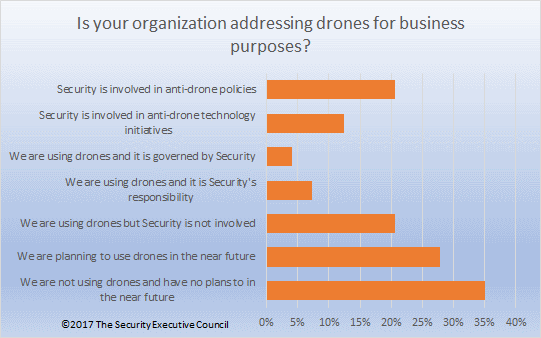The U.S.
Federal Aviation Administration expects commercial unmanned aircraft systems (UAS) "drone" purchases to grow from 600 thousand in 2016 to 2.7 million by 2020. Combining that with purchases by hobbyists brings that number up to 7 million drones in the sky by 2020.
Given the upcoming drone invasion we wanted to investigate how security practitioners were approaching the influx of UAS use in their respective organizations.
Roughly 65% of respondents to the SEC's Security Barometer quick poll reported their organization was in some way addressing drone use, but there are two sides to the drone picture. One is drone use by your organization to enable the business and the other is protecting your organization from nefarious drones. The responses from the security practitioner community represented both approaches. Over 20% of respondents reported Security was involved in anti-drone policies.

Where Drones Are Being Used
Drones are being used for varied purposes. About 20% of the organizations polled were using drones for reasons other than security. Much of this use was for data collection, for example in facilities and asset inspections, especially for items or locations that are difficult to reach otherwise. Drones were also frequently being used for photography, communications and media purposes.
When considering security related purposes, drones were being used or considered for use for activities such as surveillance, similar to fixed video cameras, and as a substitute for or an enhancement of foot patrols. Some selected responses are listed below (edited):
- Use as a substitute for security officer patrols and to investigation alarms and suspicious situations captured on CCTV.
- Alarm response, and situation awareness
- For security of high value remote installations, where manpower deployment is not possible or is cost-prohibitive.
- Monitoring remote facilities, because they are cheaper and safer than helicopters
- Using as a deterrent to unauthorized access and/or carrying payloads
- For patrol of large areas of company's property.
- Counter-surveillance... gathering proof of criminal activity remotely and planning action against such offenders.
- We are exploring the use of drones for routine security indoor patrols, providing the cost savings are enough to enable us to higher higher-skilled contract security officers.
- Event investigation and surveillance
Anti-Drone Activities
Defending against drones can be difficult from a legal perspective. Depending on governing law and regulations, some anti-drone methods may be considered illegal. Consequently, reviewing proposed activities with your legal team is recommended. Over 20% of respondents stated that Security was involved in anti-drone policies or technology initiatives. Most of these respondents appeared to be in the early research and investigation phase of their anti-drone activities. Some of the anti-drone technologies mentioned were (edited):
- Net capture
- Radio frequency detection and response teams
- Working with the FAA on airspace restriction and vigorous enforcement of FAA regulations
- Drone encounter procedures for guards and eventually for field personnel
- Drone use policies
Summary
Depending on your organization, UAS use can a business enabler and/or a risk to manage. On the positive side drones provide a level of mobility that can be difficult or expensive to achieve using other methods. The flip side is that the legal and regulatory playing field regarding anti-drone measures is somewhat ill-defined and demand careful review by your legal group.

